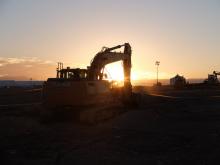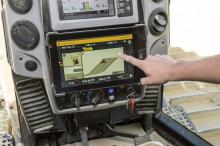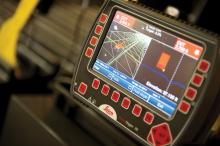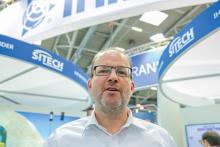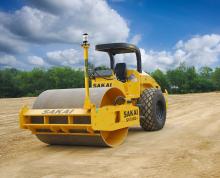The latest developments in machine control technology once again push the bar in terms of advancements. The latest systems allow contractors to work even more effectively and efficiently than before.
TeleOperation has been co-developed with LG U+, the South Korean telecommunications and data services company. Doosan claims that its TeleOperation trial is the first to remotely control a machine across such a large distance between locations using 5G telecommunications technology.
For TeleOperation to function properly, it is essential to provide the operator with live and reliable video streaming with minimal time lag. With its ultra-reliability and low latency (signal delay), the new 5G network overcomes these issues in the Doosan system, providing 10 times faster bandwidth and 10 times lower latency than the 4G network.
Special features incorporated include a low latency video transmission module with fast video transfer (with encoding and decoding). LG U+ has also introduced new modules providing low latency image processing to further minimise the time delay.
The firm has used a standard machine for the trials and it is possible to carry out both normal operation and TeleOperation with the same machine. The firm claims that its advanced technology gives the operator real-time control of the remote excavator and with high accuracy.
In the upgraded version of ConX, a new 3D visualisation of the worksite is created from data aggregation. This enables contours of the site to be shown so that, for example, an indication of the volume of earth to be moved is available immediately.
“I can estimate how much time I need to complete the task. I don’t need to get information from the field on a daily or weekly basis, which has been traditional,” said Sten Kristensen, machine control division product management director. “The beauty about this [system] is that the information could come from 10 excavators, 10 dozers or 10 dump trucks. They all report back.”
The latest version of the MC1 software, meanwhile, enables tool recognition for excavators, allowing the automatic detection of any construction tool connected to the excavator. This significantly decreases the chance of using improper buckets that could cause over-digging, increasing efficiency and productivity for operators, according to the company.
The MC1 software has previously been applied to a variety of plant such as asphalt pavers and compactors. “Now, as a project manager, I can see what that [individual] excavator is doing in real time,” said Kristensen.
Meanwhile,
Andy McCann, machine control business development manager at Topcon Positioning explained that the new package adds automatic features, rather than the light bar indicator use previously. This further reduces the risk over-cutting, with an ensuing requirement for reinstatement, and ensures that machines work accurately to grade. There is a physical restraint from excess cuts and he said, “We added a valve block to the machine to stop it from over-digging. Now it will lock out and not dig below grade.”
And the system also provides an audible warning to the operator of any danger zones to avoid, such as overhead power cables. This can be pre-preogrammed so that if a machine is working close to live traffic for example, it will prevent it from slewing into the path of oncoming vehicles. A further benefit of the system is that it helps to reduce operator fatigue when a machine is being used for digging to grade in flat, stepped or sloped applications.
Murray Lodge, senior VP, Construction said, “With the automatic excavation system, the risk of over-digging is minimised, while productivity is maximised saving time and reducing costs.”
The automatic excavation system also features a new calibration method that uses a total station which communicates wirelessly with the system, rather than typing in values manually. This is quicker and reduces the risk of errors. A further benefit of this technology is that it can be used as a retrofit. The firm says that its earlier 2D package can now be upgraded to 3D status, also incorporating the new fully automatic excavation package.
The company says that this new system is being released alongside a new version of the Topcon Haul Truck application, which uses an Android or iOS app that can be installed on a smartphone or tablet. It is designed to provide a complete cloud-based, real-time haul management and reporting infrastructure.
“The new Haul Truck app is integrated in the Topcon site management platform and provides a complete load tracking and reporting system as well as real-time truck reporting during haul operations. The app pairs nicely with the new X-53x automatic for a more safe and integrated excavation and loading ecosystem,” said Lodge.
From
The Earthworks semi-automatic boom and bucket control can now be used with tilt automatics on units from
Wegener added, “Any of the machines supported by Trimble Earthworks get this capability also.”
This allows for more accurate grading with fewer passes, so that contractors can work to grade in a shorter time period, minimising costs and maximising productivity.
And Trimble is also adding additional upgrades to its new Earthworks GO! package, which is designed for use on compact machines. The package offers 2D grade control and can be used with grading attachments on compact machines. The company claims that the package means that contractors can boost grading accuracy when using skid steer loaders or compact loaders fitted with grading attachments. The system can connect wirelessly to a smartphone, offering contractors a sophisticated earthmoving tool. It can be used on machines from most major manufacturers and is now available for ATI Level Best PD Series box blades.
The package is designed for use by contractors in applications such as general construction, site preparation and utility work. It applications include uses for grading flat and simple slopes.
Laser guidance allows users to grade or cut profiles quickly and accurately and the firm claims that the package is easy to learn and use. Productivity can be increased by up to 20% and the package includes software that provides tools showing how best to install, commission and utilise the system. The package allows users to save a machine profile in the system, so that settings can be retained. This means that the package can be switched from one machine to another, without having to replicate set-up procedures each time.
Trimble has also added to the agreements it has with machine manufacturers. Users of

